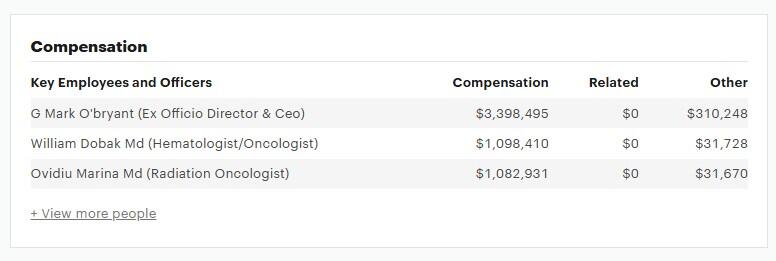A review of tax documents has discovered that Tallahassee Memorial Healthcare CEO Mark O’Bryant received $3.7 million in compensation in 2021. This finding follows a TR report revealing $3.1 million in compensation for O’Bryant in 2024.
Over the last five years, O’Bryant has received $11.6 million in compensation for an annual average of $2.3 million. This average is higher than the annual compensation of hospital CEO’s at Shands in Gainesville, Tampa General Hospital and Lakeland Regional Medical Center.
The compensation for high level officials has become an issue during the negotiations between FSU and TMH related to the academic medical center. In May of this year, the Tallahassee Democrat published an article on the issue. In that article, it was noted that TMH officials declined to disclose O’Bryant’s 2025 compensation.
Confusing Answer
The level of compensation and the response from TMH explaining the increase in the 2024 compensation ($3.1 million) when compared to the 2023 compensation ($1.8 million) is not consistent with numbers provided in IRS tax documents.
When TR reported the 2024 compensation of $3.1 million, TMH Vice President and Chief Communications Officer Stephanie Derzypolski said the compensation included “a one-time payout from an enhanced retirement plan.” (This enhanced retirement plan is in addition to O’Bryant’s 457(F) retirement plan maintained by TMH.)
However, a tax document shows O’Bryant received another “one-time payout from an enhanced retirement plan” of $2.4 million in 2021 making the total 2021 compensation $3.7 million.
The IRS Form 990 labels the “enhanced retirement plan” monies as “other reportable compensation” in a category called “supplemental nonqualified retirement plan.”
The IRS defines a “supplemental nonqualified retirement plan” as a plan that is not generally available to all employees but is available only to a certain class or classes of management or highly compensated employees. These plans are typically used to supplement an employee’s qualified plan or serve as an additional compensation tool for highly compensated individuals. They are not subject to the same tax-favored treatment as qualified plans and are often used to provide specialized forms of compensation to key executives or employees instead of making them partners or part owners in a company or corporation.
Compensation Comparison
Over the last five years (2020-2024), O’Bryant has received $11.6 million in compensation for an average annual compensation of $2.3 million. For the same period, this is higher than the average CEO compensation at Shands ($1.83 million), Tampa General Hospital ($1.98 million), and Lakeland Regional Medical Center ($1.8 million). All available compensation numbers were calculated using the same IRS Form 990 reporting categories, including “other reportable compensation.”
For comparison purposes, the 2024 annual revenue for the hospitals in the comparison were TMH – $1.0 billion, Shands $2.3 billion, Tampa General Hospital – $3.1 billion, and Lakeland Regional Medical Center $1.3 billion.

